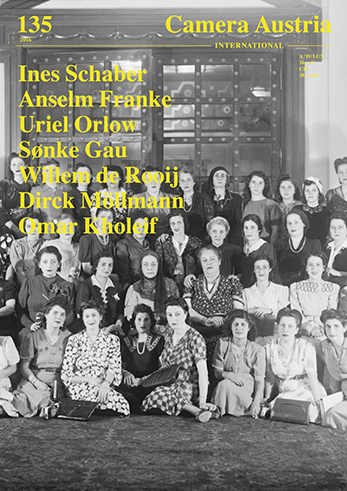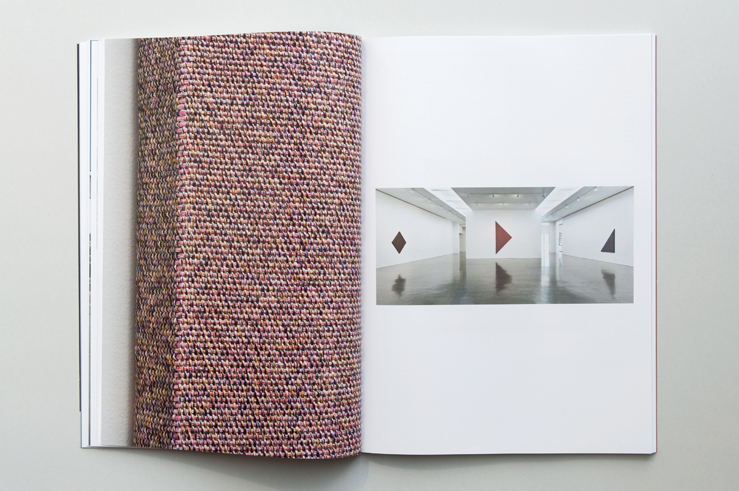Camera Austria International
135 | 2016
- ANSELM FRANKE
Ines Schaber: Against the Spell of the Given - INES SCHABER
- SØNKE GAU
Uriel Orlow: Attempts to Represent the Unrepresentable: On Stories between Words, Images, and in the Gaps of History - URIEL ORLOW
- DIRCK MÖLLMANN
Body Parts: Letters to Willem de Rooij - WILLEM DE ROOIJ
- OMAR KHOLEIF
Carrying the Weight of the World

Preface
“History is equally a question of knowledge and narration, and very much a question of the position from which it is told,” writes Anselm Franke in his essay on the works of Ines Schaber. He also writes that “a society receives its characteristic imprint at the margins.” With these words, Franke not only approaches the political core of Schaber’s works; he also sums up the key interest of the present issue: the image’s oscillation between the visual and non-visual, between seeing and knowing, a resonance between words and images that harbour an unnamed location from which they show things and from which they show themselves in order for something else to simultaneously disappear. And it’s not only images that are missing; something is also missing in the images. This absence, however, is not simply invisible; rather, it marks the basic ambivalence and controversy of the images: as appearance, as classification, as narrative, as history, as politics. It is the location of the images’ unrest and of their role in the generation of meaning.
Read more →Camera Austria International 135 | 2016
Preface
“History is equally a question of knowledge and narration, and very much a question of the position from which it is told,” writes Anselm Franke in his essay on the works of Ines Schaber. He also writes that “a society receives its characteristic imprint at the margins.” With these words, Franke not only approaches the political core of Schaber’s works; he also sums up the key interest of the present issue: the image’s oscillation between the visual and non-visual, between seeing and knowing, a resonance between words and images that harbour an unnamed location from which they show things and from which they show themselves in order for something else to simultaneously disappear. And it’s not only images that are missing; something is also missing in the images. This absence, however, is not simply invisible; rather, it marks the basic ambivalence and controversy of the images: as appearance, as classification, as narrative, as history, as politics. It is the location of the images’ unrest and of their role in the generation of meaning.
“For Ines Schaber, the photographic image exists between knowing and seeing, in a liminal realm of hauntedness, shadowy contours, and political figurations, cast as a field that is shaped by political histories of division.” Her works often involve single or multiple historical photographs, messages sent through time in the form of letters and commentaries as well as her own photographs of landscapes that revolve around the places and stories of the found pictures. She reactivates the meaning of places and events that are fragmentary and often concealed as a “revolt against the given” and the seemingly secure.
In his essay on Uriel Orlow, Sønke Gau also operates on the assumption that history is not simply a given and can’t be seen as an objective, homogenous, linear order. Methods of microhistory are one of the artist’s key points of reference in his works and are based on extensive research into histories. Accordingly, the points of departure for his research are specific locations that can be described as secondary settings. Places connected to events not accounted for in or omitted from the hegemonic historical account – its “blind spots” that are no less important, but represent intersections of various narratives. Once again: a society receives its characteristic imprint at the margins.
Dirck Möllmann wrote four letters to Willem de Rooij, in which he inquires into and expands upon one of the artist’s works or series in a downright intimate way. “An artwork, like letters, lives from the gaps in reality, from stumbling in the machinery of meaning, that it problematises … You disseminate representations in a new way and thus turn them into images. They critically examine the seeing and making of pictures. Their context extends over into the political, the distribution becomes meaningful, critical, reflexive as always. Yet you work against the pressure to reference. This power throws meaning into limbo, both here and there.”
Provisional and speculative strains carry through all three contributions, although it would be a fundamental misunderstanding to confuse this with imprecision or randomness. On the contrary: “Reckoning with the forces of ambiguity never exculpates one from historical precision while understanding the image as a limit-condition.” (Franke)
In an expanded Forum, we present ten young positions that illustrate the various tendencies in contemporary photography: formal experiments, approaches involving installation and performance, working with or establishing image archives. And in these, histories often play a significant role as well.
Reinhard Braun
and the Camera Austria Team
September 2016
Cover: Unknown photographer, Arab Ladies’ Union group at K.D. Hotel [i.e., King David Hotel]. Sept. 15. ’44. Courtesy: Library of Congress Washington, DC, Matson Collection. Ines Schaber, from the project: Dear Jadwa, 2009.
Entries
Forum
Presented by the editors:
Johanna Jaeger
Kalinka Gieseler
Stefan Klampfer
Linda Reif
Diego Ballestrasse
Jewgeni Roppel
Maya Meissner
Jonas Feige
Michael Adno
Susanne Hefti
Exhibitions
Black Chronicles. Photographic Portraits 1862 – 1948
National Portrait Gallery, London
Made You Look. Dandyism and Black Masculinity
Photographers’ Gallery, London
CHRISTINE EYENE
Mapping the Body. The Body in Contemporary Life
Galerie im Taxispalais, Innsbruck
MARINA VISHMIDT
Women at Work
Edith-Russ-Haus für Medienkunst, Oldenburg
REINHILD FELDHAUS
Ben Rivers: Islands
Kunstverein in Hamburg
JENS ASTHOFF
Mohamed Bourouissa: Hustling
Basis, Frankfurt
MORITZ SCHEPER
Clemens von Wedemeyer: P.O.V.
n.b.k., Berlin
JULIA GWENDOLYN SCHNEIDER
Crisis as Ideology?
Kunstraum Niederösterreich, Vienna
MARGIT NEUHOLD
Watched! Surveillance, Art and Photography
Hasselblad Center, Gothenburg,
Kunsthal Aarhus, Galleri Image, and ARoS, Aarhus
C/O Berlin
SARA CALLAHAN
Between One Time and Another
Temporary Gallery, Cologne
HOLGER OTTEN
Überwachen und Schlafen
Triennale 50 JPG: 50 Jours pour la photographie
Centre de la photographie Genève and various places, Genève
JÖRG SCHELLER
Made in L.A. 2016: a, the, though, only
Hammer Museum, Los Angeles
OMAR KHOLEIF
The Present in Drag — 9th Berlin Biennale for Contemporary Art
KW Institute for Contemporary Art, Akademie der Künste and various places, Berlin
ANA TEIXEIRA PINTO
The Keeper
New Museum, New York
NICOLAS LINNERT
Danny Lyon: Message to the Future
Whitney Museum of American Art, New York,
de Young, Fine Arts Museums of San Francisco
Fotomuseum Winterthur
C/O Berlin
RACHEL BAUM
Ingeborg Strobl
LENTOS Kunstmuseum Linz
MANISHA JOTHADY
Beton
Kunsthalle Wien, Vienna
SABINE WEIER
Aglaia Konrad: From A to K
M – Museum Leuven
ARNE SCHMITT
Timm Rautert: Bildanalytische Photographie 1968 – 1974
Kupferstich-Kabinett, Dresden
FALK HABERKORN
Books
Beobachter einer Institution
Regine Hauch, Timm Rautert: Im Kranken-
haus. Der Patient zwischen Technik und Zuwendung
Ernst & Sohn, Berlin 1993
Gilles Raynaldy: Jean-Jaurès
purpose éditions, Paris 2015
JAN WENZEL
Corinne Silva: Garden State
Ffotogallery and The Mosaic Rooms, London 2016
FRANCESCA LAURA CAVALLO
Camille Henrot: Prehistoric Collections
Manuella Éditions, Paris 2015
CHRISTINA TÖPFER
Documentary Across Disciplines
The MIT Press, Cambridge 2016
TACO HIDDE BAKKER
Imprint
Publisher: Reinhard Braun
Owner: Verein CAMERA AUSTRIA. Labor für Fotografie und Theorie.
Lendkai 1, 8020 Graz, Österreich
Editors: Margit Neuhold, Sabine Weier.
Translations:Dawn Michelle d’Atri, Wilfried Prantner, Dunja Opatić, Andrea Scrima.
English proofreading: Dawn Michelle d’Atri, Andrea Scrima.
Acknowledgments: Michael Adno, Verle Ausloos, Diego Ballestrasse, Anamarija Batista, Louis de Belle, Julia Debus, Jonas Feige, Jacek Fota, Anselm Franke, Sønke Gau, Kalinka Gieseler, Emma Jacobson-Sive, Johanna Jaeger, Dejan Kaludjerović, Omar Kholeif, Stefan Klampfer, Isabella Kohlhuber, Sandra Krizic Roban, Maya Meissner, Dirck Möllmann, Uriel Orlow, Maud Pollien, Linda Reif, Willem de Rooij, Jewgeni Roppel, Ines Schaber, Arne Schmitt, Ingeborg Strobl.
Copyright © 2016
No parts of this magazine may be reproduced without publisher’s permission.
Camera Austria International does not assume any responsibility for submitted texts and original materials.
ISBN 978-3-902911-27-8
ISSN 1015 1915
GTIN 4 19 23106 1600 5 00135









